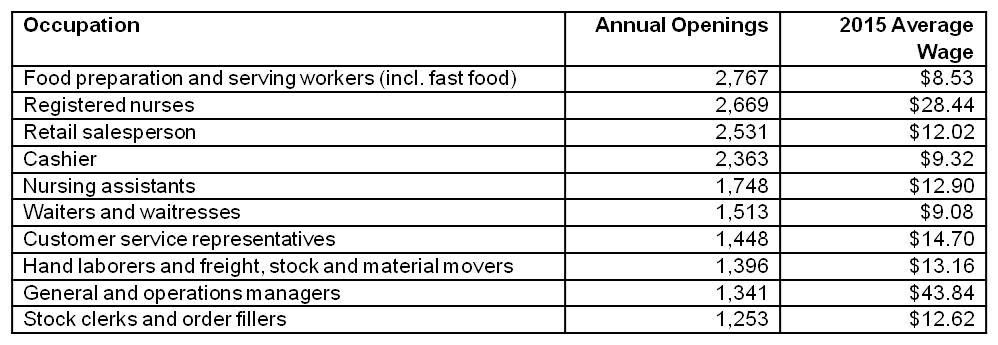Anecdotal claims are often made that many good jobs are available across the state but Kentucky lacks a workforce skilled and responsible enough to fill those jobs. But the fact is our economy is comprised of many jobs that offer low wages and have few skill requirements — jobs that Kentuckians are working every day.
The Education and Workforce Development Cabinet released its updated occupational outlook report for the years 2014 to 2024 last summer, and recently created a new interactive tool to share related data. Rather than lots of high-skill, high-wage jobs, these reports show the majority of available employment is in relatively low wage, low skill occupations.
According to the outlook report, 66 percent of jobs in Kentucky required only a high school diploma or less in 2014. By 2024, the share is expected to be 64.6 percent, only a slight decline from 10 years earlier.
Most of the specific occupations with the greatest anticipated number of openings over the next 10 years also have low skill requirements and pay low wages. As shown in the table below, 8 of the 10 most common occupations pay less than $15 an hour on average, and 3 pay less than $10 an hour. Of these top jobs, only two require an associate’s degree or higher (registered nurses and general/operations managers).
Source: Education and Workforce Development, Kentucky Occupational Outlook to 2024.
This data is in line with other information suggesting 30 percent of Kentuckians are in jobs that pay less than $12 an hour. In contrast, a family of 3 in rural Kentucky needs about $24 an hour in full-time, year-round work to meet basic family needs.
The outlook report also notes greater educational attainment is generally associated with higher wages, an idea that is widely understood. The best choice for an individual remains getting more education and training. However, for the workforce as a whole, the vast majority of jobs remain in occupations that do not require such training. While more can be done to improve the extent to which employers utilize workers’ skills in those jobs, there is also a need for strategies besides education to lift job quality.
Examples of policies that can make jobs better (and thereby inject more money into our local economies) include a substantial increase in the minimum wage, including for tipped workers; an expansion of income supports like the Earned Income Tax Credit and the protection of Medicaid expansion, which provides many low wage workers with health insurance. We should also be making it easier, not harder, for service sector workers to bargain for better wages.
Anecdotal claims about the quality of our workforce are often used to undercut such policy improvements. If the jobs out there are great, but the people are lacking, it is easy to put the blame on the workers. But the data challenges the dominant myths about Kentucky’s workers and the jobs available in our economy. Kentuckians are showing up to work every day in low wage jobs at restaurants, retail stores, nursing homes and more. Many face challenges at such jobs with irregular scheduling, wage theft and lack of access to sick leave in addition to low pay and little respect—even while CEO pay soars and corporate profits are at record highs.
We need an agenda much more focused on improving the quality of jobs that Kentuckians have today, an agenda based on facts and not myths.




